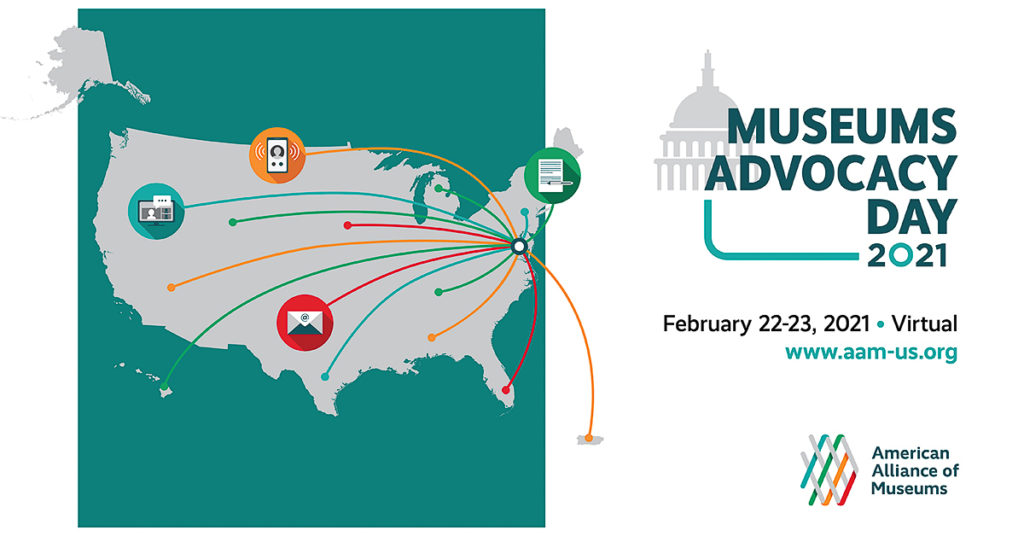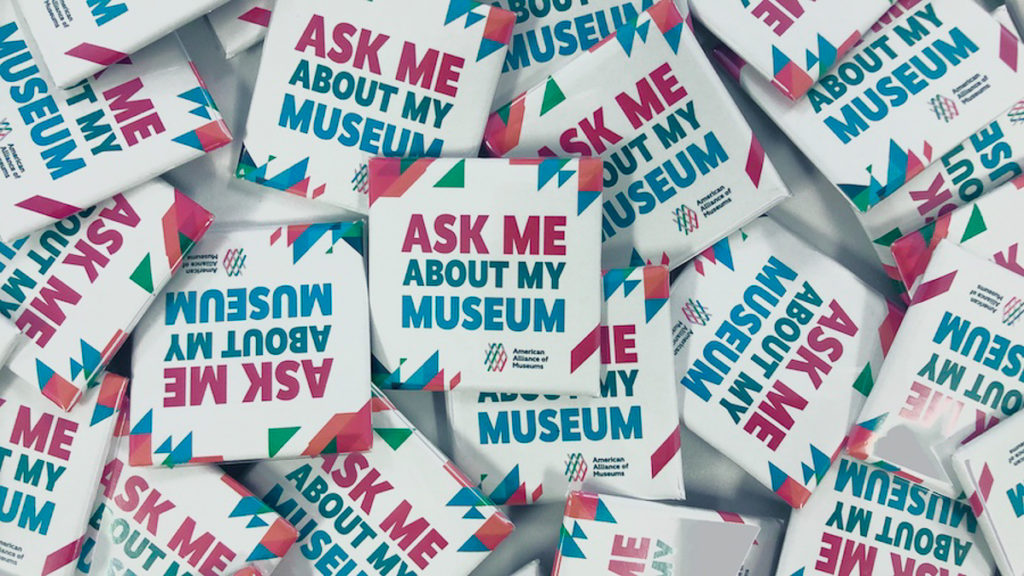Each year the American Alliance of Museums organizes Museums Advocacy Day, an event aimed at preparing and enabling public history professionals and individuals who are passionate about museums to speak directly with their Congressional representatives about policy issues that directly affect museums. This year, the event starts today – February 22 – with several sessions focused on the issues and how to advocate, which will then be followed tomorrow by a day of Congressional meetings to talk to representatives and/or their staff about why they should support museums and their work. Due to the COVID-19 pandemic, the whole event this year will be virtual, which may seem like a disadvantage, but actually it makes speaking with elected officials and advocacy easier and more accessible. In fact, it is the first year that members of our curatorial staff have been able to attend!
But, what makes museums so important? Why should we advocate for museums? And what can you do today to support your local museum?
Why Are Museums Important?
In all probability, if you’re reading this blog post, you already have a love for museums. So I want you to think about the first time you went to a museum. Did you feel giddy with excitement and wonder as you looked in the beautiful glass cases that housed items ancient and seemingly ripped from our collective imagination? Did you tell your friends and teachers about all of the neat facts you learned and all of the cool objects you saw? Did you perhaps decide to go to your local museum’s summer camp or their other public events after this initial visit? I always come out of museums refreshed and grounded by a deeper understanding of the represented community and also a deeper understanding of myself. And then I want to see and learn more.

Visitors engage with the Things Come Apart special exhibit, which was featured at the museum in 2017. One good experience can lead to continued support of your museum in a variety of ways, including advocating for your mission and work. © Birthplace of Country Music; photographer: Billie Wheeler
These feelings are not unfounded. The American Alliance of Museums has done extensive research on the impact museums have on the individual, community, education, and the economy. Here are just a few of their findings:
- Museums support more than 726,000 American jobs.
- Museums contribute $50 billion to the U.S. economy each year.
- Children who visited a museum during kindergarten had higher achievement scores in reading, mathematics, and science in third grade than children who did not. Children who are most at risk for deficits and delays in achievement also see this benefit.
- Americans view museums as one of the most important resources for educating our children and as one of the most trustworthy sources of objective information. According to a study by Indiana University, museums are considered a more reliable source of historical information than books, teachers, or even personal accounts by grandparents or other relatives.
- In determining America’s Best Cities, Bloomberg Business Week placed the greatest weight on “leisure amenities [including density of museums], followed by educational metrics and economic metrics…then crime and air quality.”
- More people visited an art museum, science center, historic house or site, zoo, or aquarium in 2018 than attended a professional sporting event.
- Museums also provide many social services, including programs for children on the autism spectrum, English as a Second Language classes, and programs for adults with Alzheimer’s or other cognitive impairments.
- Since 2014, more than 500 museums nationwide have facilitated more than 2.5 million museum visits for low-income Americans through the Museums for All program.
To learn more about the awesome effects of museums at the individual, communal, and global level, visit the American Alliance of Museums’ website here – it’s full of great information!

The AAM website graphic for Museums Advocacy Day 2021.
Why Advocate?
What does it even mean to advocate? On the most basic level to advocate is to publicly recommend or support – this definition of advocate could cover everything from recommending a friend to your current employer for an open position within the organization to supporting a local artist you love by sharing their work on your social media pages. On the political level, to advocate means to actively support a change to an issue or creation of program or solution on a local, state, or federal level. Political advocacy includes emailing, writing letters to, or calling your lawmakers; voicing your opinions or sharing other calls to action on your social media pages and tagging lawmakers in those posts; or participating in or supporting advocacy or action groups who are dedicated to specific issues.
But why get involved? AAM outlines several great reasons to advocate:
- It is your right (and duty) as an American citizen to advocate for what you believe in.
- It can bring about policy change that will make others’ lives better.
- You can help speak up for those who may not be able to speak for themselves.
- It is evidence of our political system at work – it helps fulfill checks and balances on the government.
- It underlines that you are an active member of the community – politicians may be too far removed to really understand the issues and what is going on in communities.
- It can actually accomplish something!

Buttons provided by AAM for a past Museums Advocacy Day encouraged those representatives and aides met on Capitol Hill to learn about individuals and their museums. Source: https://blooloop.com/museum/news/aam-museum-advocacy-day/
Finally, remember to keep an open mind about advocacy. It is no different than an institution participating in donor cultivation – museums are community centers that preserve, celebrate, and engage a community as a whole and as such it is acceptable to share that impact and advocate for these organizations.
What Can You Do as an Individual?
So…you think museums are amazing, and hopefully now advocacy doesn’t sound so intimidating, but what are some tangible action items you can do to help your local museum on the individual, rather than the institutional, level? Again, the American Alliance of Museums has a list of do-ables to help you advocate for the museums you love:
- Contact your Congressional representative (contact information and templates can be found here) and tell them why your local museum is important to you and your community. And don’t just look at the national level – you can also contact your state and local representatives, where your words might have even more impact.
- Learn from others about why they advocate and what issues they think are important.
- Make advocacy a habit, not just a one-off action.
- Stay informed on the issues important to your community.
- Visit your local museum to learn more about their work and their contributions to your community.
- Ask your favorite museum or historic/cultural organization how you can help!
For more information, check out the sources used for this post:


